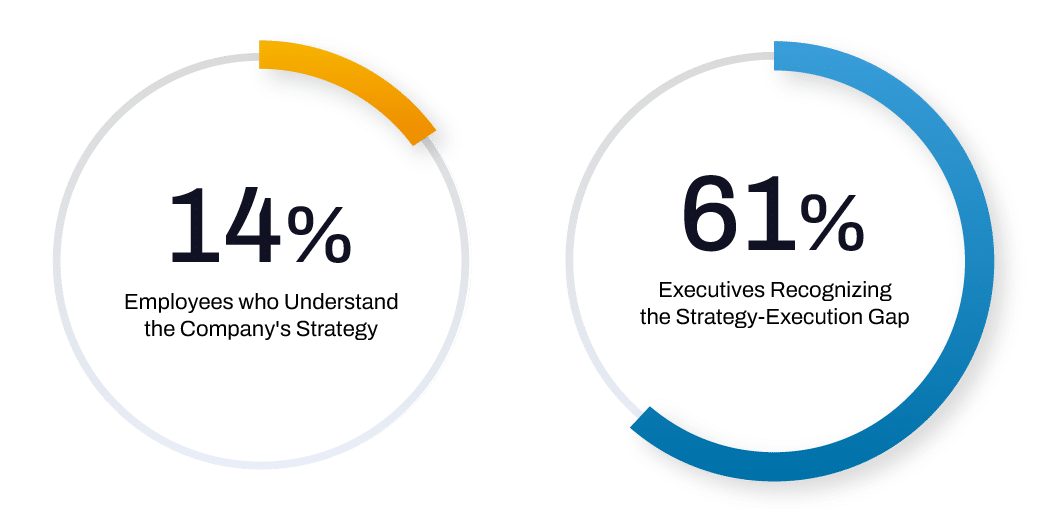Strategic Alignment
Strategic Alignment: Aligning Planning, Process & Culture
Maximizing strategic alignment is critical to improving overall performance. To achieve this, several best practices have been established that have shown significant positive impacts. This is a comprehensive look into the best practices for achieving strategic alignment, supported by recent research.
Strategic Alignment Process
Align Vision, Strategy, OKRs & Culture
If you have a process for aligning strategy, OKRs, and employee behaviors, you can significantly improve performance, creating strategic alignment and a source of competitive advantage. If you don’t have a strategic alignment process you might find that you are disadvantaged.
Company Alignment Starts With Your Winning Aspiration
Your strategic alignment process starts by establishing a clear winning aspiration. It will serve as the foundation for strategic alignment by providing guidance on the overall direction and purpose of the company. They also have the potential to inspire, create urgency and purpose.
FREE BOOK DOWNLOAD
Force Multipliers
Download a full preview of Force Multipliers, written by ZOKRI co-founder Matt Roberts.
Force Multipliers takes you through a revolutionary Business Operating System (BOS) to overcome growth plateaus and supercharge scaling efforts. A blend of practical strategies and real-world insights designed to streamline operations and enhance strategic agility.
- Pinpoint Customer Value
- Develop Winning Strategy
- Importance Of Keeping Score
- Aligning People & Culture
- Developing OKR Competency
- High Performing Rituals & Habits
Research by Desmidt, Prinzie, & Decramer has shown that companies with a vision for the future exhibit better financial performance and employee engagement. The Corporate Executive Board found that companies that have a strong, shared sense of purpose achieve a 10-year total shareholder return that is five times higher than their peers. This finding also highlights the importance of defining and communicating a company’s vision to all stakeholders.
Strategy, KPI Scorecards & OKRs Come Next
The job of strategy is to define your “field of play” – customer, market, geography, niche etc. and articulate how you propose to win.
How you get to a position where you can articulate your strategy is called a ‘Strategic Planning Process“. This involves a process whereby you create strategic perspectives or pillars along with strategic narratives and KPI scorecards. You can then use the the OKR framework to create goals that prioritize effort and resources, whilst creating focus and accountability from week-to-week.
Research has consistently shown that clear strategic objectives are crucial for strategic alignment. Companies that excel at articulating their goals tend to outperform their competitors in various aspects, including revenue growth, profitability, and employee satisfaction.

One popular ways to articulate your strategy is using Strategic Pillars with associated OKRs and KPI scorecards. Our OKR planning process is designed to help you focus on the goals that will have the greatest impact and give you the accountability and executional focus to then achieve these goals.
Other Factors That Impact Alignment
Agility
Agility is essential in today’s dynamic business environment, where companies must adapt quickly to stay competitive. According to a study by Deloitte, 94% of executives and 88% of employees believe that agility and collaboration are crucial to their companies success.

To enhance agility, companies should adopt flexible organization structures that promote cross-functional collaboration and empower employees to make decisions quickly. This may involve flattening hierarchies, creating autonomous teams, and streamlining decision-making processes.
Leadership
Unsurprisingly, strong leadership is critical for creating and maintaining organizational alignment.
In particular, leaders need to set clear expectations and provide guidance and support to ensure that all units work together towards common goals. According to a study by Gallup, organizations with highly engaged leadership teams are 21% more productive and achieve 22% greater profitability.

A strategic planning, OKR and performance management process and systems like ZOKRI makes this easier, and you’re able to engage more when you know which areas of the business need the most support.
Effective Communication
A common area of employee frustration is communication. Effective communication is essential for aligning different units within a company. This includes both formal and informal channels of communication. A study by Towers Watson found that companies with effective communication practices have a 47% higher total return to shareholders compared to those with poor communication practices.

Goal role, plan clarity, transparency, accountability and a flow of information on progress, issues, and wins goes a long way to helping people feel part of the whole. This can all be achieved in ZOKRI. Add to this regular company meetings and town-halls, and team check-ins, you can come a long way fast on this.
Employee Empowerment
Empowering employees to make decisions and take ownership of their work has been shown to contribute to strategic alignment. When employees feel empowered, they are more likely to be engaged and committed to the companies goals. A study by Grawitch, Gottschalk, and Munz found that employee empowerment is positively correlated with job satisfaction, commitment, and job performance.
Aligned With The 7S Model from McKinsey
The 7S model of strategic alignment is a framework developed by McKinsey & Company in the late 1970s. The model identifies seven factors that are critical for alignment. The seven factors are:
- Strategy: The organization’s plan for achieving its goals and objectives.
- Structure: The way the organization is organized, including its hierarchy, reporting lines, and communication channels.
- Systems: The procedures, processes, and tools used by the organization to execute its strategy.
- Shared values: The core beliefs and values that guide the behavior of the organization’s employees.
- Skills: The capabilities and competencies of the organization’s employees.
- Staff: The organization’s workforce, including its size, diversity, and skills.
- Style: The leadership style and culture of the organization, including its management practices and decision-making processes.
According to the 7S model, all seven factors must be aligned and integrated. In other words, changes in one factor can impact the other factors, and a change in any one factor may require adjustments in the others to maintain alignment.
The model above is consistent with the 7s Model, all of which can be platformed in ZOKRI. Using ZOKRI ensures there is less execution risk and a far greater chance of success.
Start Aligning Strategy & Culture With A Strategic Alignment Framework
There is a powerful approach to creating strategic alignment – one that combines the clarity of a vision, the logic of strategic narratives, the precision of KPI scorecards, and the focus of OKRs. This synergy is essential for building companies that are not only successful but also truly inspiring. This approach is followed and coached in our own strategic alignment framework.
What happens when you successfully combine your winning aspiration, strategic pillars, OKRs, and KPI scorecards to create company alignment?
You build a company that is focused, agile, and resilient. You create an environment where every individual knows their purpose and understands how their work contributes to the broader vision. You foster a culture of collaboration, where people work together to achieve shared objectives. And you promote a mindset of continuous learning, where we regularly review your performance and make adjustments based on the data.
Creating alignment through a clear vision, strategy, OKRs, and KPI scorecards is essential for building successful companies. By harnessing the power of these tools, you can create a world where everyone knows their purpose and works together towards a shared goal.
Free Training Sample
Executive Briefing On OKRs
This is a 15 minute executive briefing on what is needed to successfully use Objectives & Key Results (OKR) to deliver your strategy, increase performance, & improve culture.
Simple, Effective & Powerful
All-in-One Business Growth Software Solution
ZOKRI has the all of the planning tools and execution processes you need to align, focus and increase effective output.
-
Strategic Planning Excellence
Strategy, OKRs and KPI Management that works the way you do.
-
People & Cultural Alignment
Define roles, responsibilities and values and recognize alignment.
-
Streamlined Updates & Meetings
Check-ins and high-impact meetings made really simple.
Discover An 8 Step Strategic Planning Process That Helps You Ignite & Sustain Business Growth
- Startling Numbers
- Overview Of Each Step
- Preparing To Plan
- Values & Guiding Principles
- Customer Value
- Where Can We Play and Win
- Table Stakes vs Wow Moments
- What Do We Know
- What Is Our Winning Strategy
- Which Goals Do We Need To Commit To Next?
- Having The Right People In The Right Roles
- What Management Systems Are Required
- Launch Your Strategy
- Expert Help & Support
- Forcing The Selection
- Step Change Thinking
FREE RESOURCE
The Concepts & Ideas Used To Create & Manage High Performing Companies
Take a journey through the business concepts and ideas that are the hallmarks of high performing companies and teams. Choose the ones that are right for you. Platform your choices easily and cohesively in ZOKRI.
- United Kingdom
Ashtead
KT21 1RZ
+44 20 7046 1328

- United States
New York
NY 10013
+1 646-718-4720
- ZOKRI helps leaders and teams achieve strategic goals using the OKR (Objectives & Key Results) framework. Our platform aligns strategy, goals, and people, fostering engagement and growth through comprehensive training and management systems.
© ZOKRI 2025 All rights reserved | Privacy Policy | Terms & Conditions | GDPR
Contacts Us
Tell us what you need. We'd be delighted to help.
"*" indicates required fields